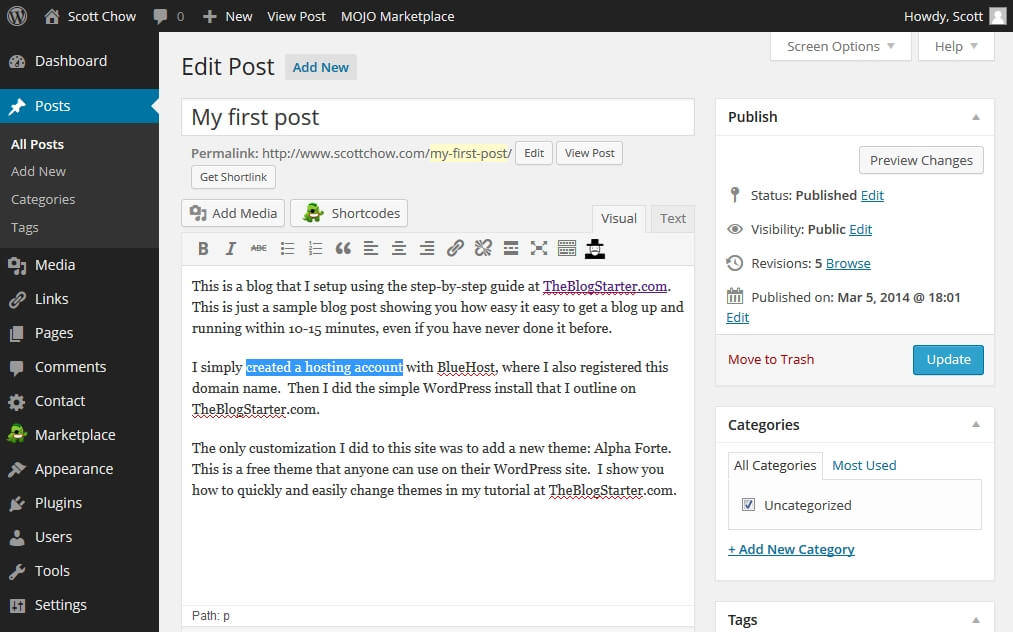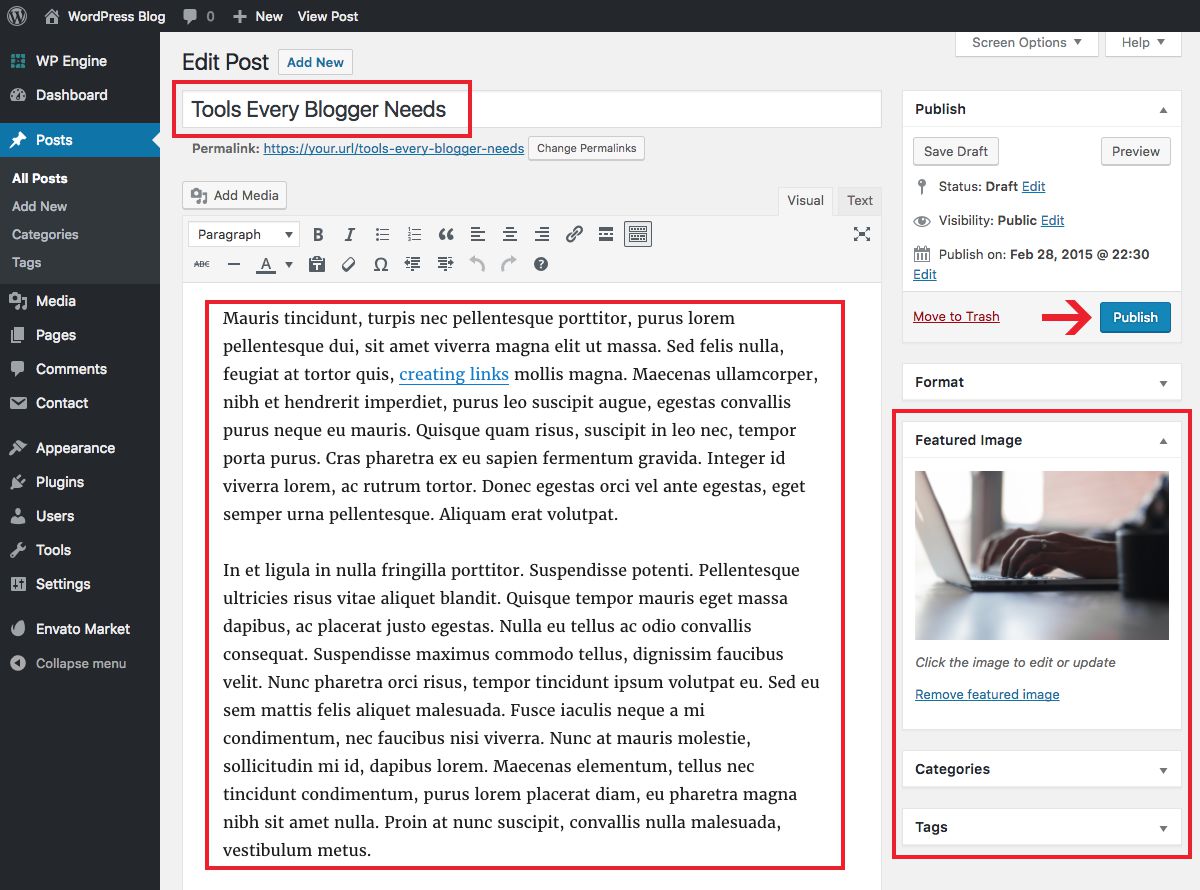By the end of this project, you will create a blog site with a home page and initial blog post using a free content management system, WordPress. You will be able to create a business blog with the look and feel of a website complete with options for e-commerce plugins. A blog page (more commonly referred to as an archive page), on the other hand, is a static page that includes all the blog posts. On it, posts are usually listed in reverse chronological order, showing the newest posts first, which makes sense, given that you want your readers to read your latest posts first. How to create a blog page in WordPress. A WordPress blog (or news) page is a single page that displays multiple blog posts. Blog (or news) posts can be useful for sharing organization news, member news, community issues, awards & recognition, etc. Creates a new blog (site). This function runs when a user self-registers a new site as well as when a Super Admin creates a new site. Hook to 'wpmunewblog' for events that should affect all new sites. In this guide, we will show you how to create a WordPress blog using the self-hosted WordPress step-by-step. Step 2: Choose the Right Web Hosting. As we mentioned above, WordPress requires hosting and domain. There’re many Web hosting providers out there and choosing a good one is hard especially for beginners.
Create a site.
Wordpress Create A Free Website Or Blog
Contents
- Related
Description Description
This function runs when a user self-registers a new site as well as when a Super Admin creates a new site. Hook to ‘wpmu_new_blog’ for events that should affect all new sites.
On subdirectory installations, $domain is the same as the main site’s domain, and the path is the subdirectory name (eg ‘example.com’ and ‘/blog1/’). On subdomain installations, $domain is the new subdomain + root domain (eg ‘blog1.example.com’), and $path is ‘/’.
Parameters Parameters
(string)(Required)The new site's domain.
(string)(Required)The new site's path.
(string)(Required)The new site's title.
(int)(Required)The user ID of the new site's admin.
(array)(Optional) Array of key=>value pairs used to set initial site options. If valid status keys are included ('public', 'archived', 'mature', 'spam', 'deleted', or 'lang_id') the given site status(es) will be updated. Otherwise, keys and values will be used to set options for the new site.
Default value: array()
(int)(Optional) Network ID. Only relevant on multi-network installations.
Default value: 1
Return Return
(int|WP_Error) Returns WP_Error object on failure, the new site ID on success.
Source Source
File: wp-includes/ms-functions.php
View on Trac
Related Related
Uses Uses
| Uses | Description |
|---|---|
| wp-includes/ms-site.php:wp_insert_site() | Inserts a new site into the database. |
| wp-includes/load.php:wp_installing() | Check or set whether WordPress is in “installation” mode. |
| wp-includes/cache.php:wp_cache_set() | Saves the data to the cache. |
| wp-includes/l10n.php:__() | Retrieve the translation of $text. |
| wp-includes/functions.php:wp_parse_args() | Merges user defined arguments into defaults array. |
| wp-includes/ms-functions.php:domain_exists() | Checks whether a site name is already taken. |
| wp-includes/load.php:is_wp_error() | Checks whether the given variable is a WordPress Error. |
| wp-includes/class-wp-error.php:WP_Error::__construct() | Initializes the error. |

Topics
- Database Backup Instructions
- Accessing phpMyAdmin
- Backup Resources
Note: Want to skip the hard stuff? Skip to Automated Solutions such as WordPress Plugins for backups.
Your WordPress database contains every post, every comment and every link you have on your blog. If your database gets erased or corrupted, you stand to lose everything you have written. There are many reasons why this could happen, and not all are things you can control. With a proper backup of your WordPress database and files, you can quickly restore things back to normal.
Instructions to back up your WordPress site include:
- WordPress Site and your WordPress Database
- Automatic WordPress backup options
In addition, support is provided online at the WordPress Support Forum to help you through the process.
Site backups are essential because problems inevitably occur and you need to be in a position to take action when disaster strikes. Spending a few minutes to make an easy, convenient backup of your database will allow you to spend even more time being creative and productive with your website.
Backup Questions Backup Questions
Back up your database regularly, and always before an upgrade.
How often should you back up?
Wordpress Create Blog Page
That depends on how often you blog, how often you want to do this, and how you would feel if your database were lost along with a few posts. It is your decision.
Can you use this method to back up other data?
Yes. Backups are good all around.
How many backups should I keep?
The general rule of thumb is to keep at least three backups and keep them in three different places or forms, like CD/DVDs, different hard drives, a thumbdrive, web disk, your e-mail account, etc. This prevents problems if a single backup becomes corrupted or damaged.
Can backups be automated?
Yes. There are several methods of automating the backup process available, and we’ve listed some in the Automatic WordPress backup section. However, it is highly recommended that you back up those auto backups with a manual backup once in a while to guarantee that the process is working.
Is there more information on backing up WordPress available?
Yes. See Backup Resources for more information.
Backup Documentation Backup Documentation
The following are general documents for helping you to back up and restore your WordPress data.
Backing Up Your WordPress Site Backing Up Your WordPress Site
There are two parts to backing up your WordPress site: Database and Files. You need to back up the entire site, and you need to back up your WordPress database. Below are instructions for backing up your WordPress database for various server programs. We will start with backing up the rest of your WordPress site.
Your WordPress site consists of the following:
- WordPress Core installation
- WordPress plugins
- WordPress themes
- Images and files
- JavaScript, PHP, and other code files
- Additional files and static web pages
All of these are used in various combinations to generate your website. The database contains your posts and a lot of data generated on your site, but it does not include the above elements that all come together to create the look and information on your site. These need to be saved.
Most hosts back up the entire server, including your site, but it takes time to request a copy of your site from their backups, and a speedy recovery is critical. You need to learn how to back up your own site files and restore them.

Here are some methods to backup your site files:
Website Host Provided Backup Software
Most website hosts provide software to back up your site. Check with your host to find out what services and programs they provide.
Create Sync With Your Site
WinSCP and other programs allow you to sync with your website to keep a mirror copy of the content on your server and hard drive updated. It saves time and makes sure you have the latest files in both places.
Copy Your Files to Your Desktop
Using FTP Clients or UNIX Shell Skills you can copy the files to a folder on your computer. Once there, you can compress them into a zip file to save space, allowing you to keep several versions.
Remember, keep at least three backups on file, just in case one is corrupted or lost, and store them in different places and on different mediums (such as CD’s, DVDs or hard drives).
Database Backup Instructions Database Backup Instructions
Back up your WordPress database regularly, and always before an upgrade or a move to a new location. The following information will help you back up your WordPress database using various popular server software packages. For detailed information, contact your website host for more information.
Accessing phpMyAdmin Accessing phpMyAdmin
See phpMyAdmin for more information on phpMyAdmin.
While familiarity with phpMyAdmin is not necessary to back up your WordPress database, these instructions should take you step-by-step through the process of finding phpMyAdmin on your server. Then you can follow the instructions below as a simple and easy backup. For more detailed instructions, see Backing Up Your Database.
Plesk Plesk
On your Websites & Domains screen, click Open button corresponding to the database you have set up during the WordPress installation. This will open phpMyAdmin interface:
If you cannot see the Open button, make sure to close the Start creating your website prompt:
Click Select Existing Database to find select your WordPress database:
cPanel cPanel
On your main control panel for cPanel, look for the MySQL logo and click the link to MySQL Databases. On the next page, look for phpMyAdmin link and click it to access your phpMyAdmin.
Direct Admin Direct Admin
From Your Account page, look for MySQL Management and click it to access phpMyAdmin.
Ensim Ensim
Look for the MySQL Admin logo and click the link. Under Configuration choose MySQL Administration Tool.
Wordpress Create A Free Blog
vDeck vDeck
From the main control panel, click Host Manager, then click Databases. In the next window, click Admin. Another window will popup taking you to the phpMyAdmin login screen.
Ferozo Ferozo
Login to your Ferozo Control Panel by using your credentials. Once inside, go to the “Base de Datos” (“Data Base”) menu and then click on “Acceso phpMyAdmin” (“Access phpMyAdmin”). A new window will open displaying the phpMyAdmin login screen.
Simple Backup with phpMyAdmin Simple Backup with phpMyAdmin
The following is a very simple version of Backing Up Your Database. Once you have discovered how to access your site’s phpMyAdmin, follow these simple instructions.
- Click on Databases in your phpMyAdmin panel. (It may not be necessary to do this, depending on your version of phpMyAdmin)
- You may have several databases. Click the one that holds your WordPress data, the database you created when you installed WordPress. (In older versions this may be done through a pull-down menu.)
- Below is a picture of the default tables in the Structure view tab. You may have more tables — this would happen if you have any statistics plugins or anti-spam plugins.
Wordpress Create A Blog
- Click Export.
There are two methods to export, Quick and Custom; if you choose Custom, follow these steps:

- Select all the tables.
- In the Output section check Save output to a file and select None for Compression. (If your database is very large use a compression method)
- Select SQL from the Format drop-down menu.
- Check “Add DROP TABLE”: this can be useful for over-writing an existing database.
- Check “IF NOT EXISTS”: this prevents errors during restores if the tables are already there.
- Click Go. The data will now be saved into your computer.
Automatic Backups Automatic Backups
Various plugins exist to take automatic scheduled backups of your WordPress database. This helps to manage your backup collection easily. You can find automatic backup plugins in the Plugin Browser on the WordPress Administration Screens or through the WordPress Plugin Directory.
Wordpress Create Blog
Backup Resources Backup Resources

- FTP Backups – How to automate backing up to an FTP server
- Incremental Backups – How to make encrypted incremental backups using duplicity
Wordpress Create Own Blog
Backup Tools Backup Tools

Comments are closed.